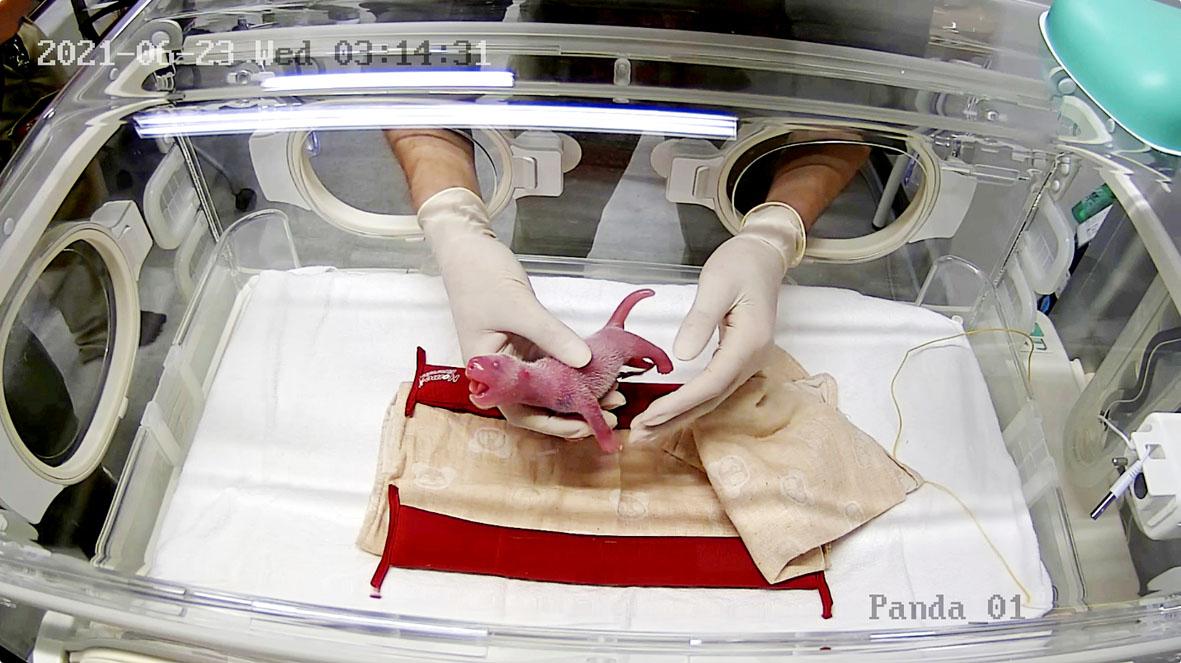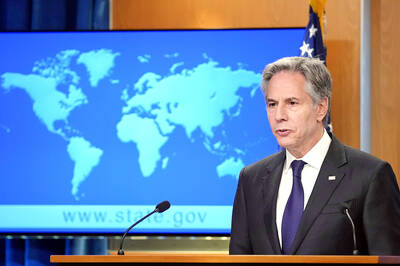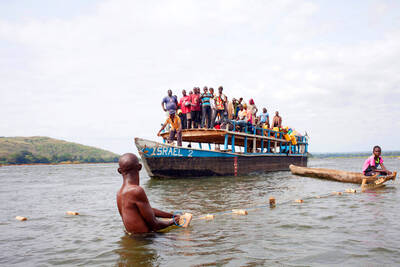A panda at Tokyo’s Ueno Zoo gave birth to twins yesterday, weeks after news of the pregnancy sent stocks in nearby restaurants soaring.
They were born in the early hours, the zoo said in a statement, adding that it had not yet confirmed the sex of the pair.
Zoo director Yutaka Fukuda said the twin birth was a first for the Ueno facility.

Photo: REUTERS / Tokyo Zoological Park Society
“When I heard the news that the second baby was born, I couldn’t help but whoop,” he told reporters.
One of the cubs, weighing 124 grams, was placed in an incubator, zoo spokesman Naoya Ohashi told a news conference later that day.
The mother, Shin Shin, “is in good health and carefully looking after” the other baby, Ohashi added.
When pandas have twins, they usually only raise one, “so we will be making sure the mother panda will breastfeed one while we keep the other in the incubator,” he said.
Zookeepers would be swapping the babies so that both cubs experience natural feeding, Ohashi added.
Shin Shin sparked a rally in stocks of eateries near the zoo earlier this month when her suspected pregnancy was announced, with investors anticipating a visitor boom to the area after the delivery.
Shares of a Chinese restaurant nearby spiked nearly 30 percent on the pregnancy and were up 6.4 percent early yesterday.
Even the Japanese government weighed in, with Japanese Chief Cabinet Secretary Katsunobu Kato calling the birth of the cubs “cheerful news” and inviting “all of Japan to watch over them.”
Zookeepers had been on alert for a possible pregnancy after Shin Shin and her partner, Ri Ri, mated in early March.
The pair are also parents of a female panda, Xiang Xiang, who was born in June 2017 and became a massive draw for the facility.
She was scheduled to be repatriated to China two years after her birth, but Japanese officials negotiated to extend her stay until the end of this year.
Japanese media have been offering regular updates on the Ueno pandas, which before the COVID-19 pandemic drew huge crowds of domestic and foreign tourists.
There are an estimated 1,800 giant pandas in the wild, mainly in bamboo forests in the mountains of China, WWF data showed.
About 600 more live in zoos and breeding centers around the world.
The International Union for Conservation of Nature classifies giant pandas as “vulnerable.”
The black and white mammals are immensely popular around the world, and China loans them out as part of a “panda diplomacy” program to foster foreign ties.
The bears are notoriously bad at reproducing, but early last month, a panda in Malaysia gave birth to her third cub during her stay there.
A newborn in Washington has enthralled Americans since its birth in August last year, with more than 1 million people tuning in on a “Panda Cam” to watch Xiao Qi Ji (小奇蹟, “Little Miracle”).

‘IN A DIFFERENT PLACE’: The envoy first visited Shanghai, where he attended a Chinese basketball playoff match, and is to meet top officials in Beijing tomorrow US Secretary of State Antony Blinken yesterday arrived in China on his second visit in a year as the US ramps up pressure on its rival over its support for Russia while also seeking to manage tensions with Beijing. The US diplomat tomorrow is to meet China’s top brass in Beijing, where he is also expected to plead for restraint as Taiwan inaugurates president-elect William Lai (賴清德), and to raise US concerns on Chinese trade practices. However, Blinken is also seeking to stabilize ties, with tensions between the world’s two largest economies easing since his previous visit in June last year. At the

UNSETTLING IMAGES: The scene took place in front of TV crews covering the Trump trial, with a CNN anchor calling it an ‘emotional and unbelievably disturbing moment’ A man who doused himself in an accelerant and set himself on fire outside the courthouse where former US president Donald Trump is on trial has died, police said yesterday. The New York City Police Department (NYPD) said the man was declared dead by staff at an area hospital. The man was in Collect Pond Park at about 1:30pm on Friday when he took out pamphlets espousing conspiracy theories, tossed them around, then doused himself in an accelerant and set himself on fire, officials and witnesses said. A large number of police officers were nearby when it happened. Some officers and bystanders rushed

Beijing is continuing to commit genocide and crimes against humanity against Uyghurs and other Muslim minorities in its western Xinjiang province, U.S. Secretary of State Antony Blinken said in a report published on Monday, ahead of his planned visit to China this week. The State Department’s annual human rights report, which documents abuses recorded all over the world during the previous calendar year, repeated language from previous years on the treatment of Muslims in Xinjiang, but the publication raises the issue ahead of delicate talks, including on the war in Ukraine and global trade, between the top U.S. diplomat and Chinese

RIVER TRAGEDY: Local fishers and residents helped rescue people after the vessel capsized, while motorbike taxis evacuated some of the injured At least 58 people going to a funeral died after their overloaded river boat capsized in the Central African Republic’s (CAR) capital, Bangui, the head of civil protection said on Saturday. “We were able to extract 58 lifeless bodies,” Thomas Djimasse told Radio Guira. “We don’t know the total number of people who are underwater. According to witnesses and videos on social media, the wooden boat was carrying more than 300 people — some standing and others perched on wooden structures — when it sank on the Mpoko River on Friday. The vessel was heading to the funeral of a village chief in